Constrained Jackiw-Rebbi model gives McGreevy-Swingle model Please share
advertisement
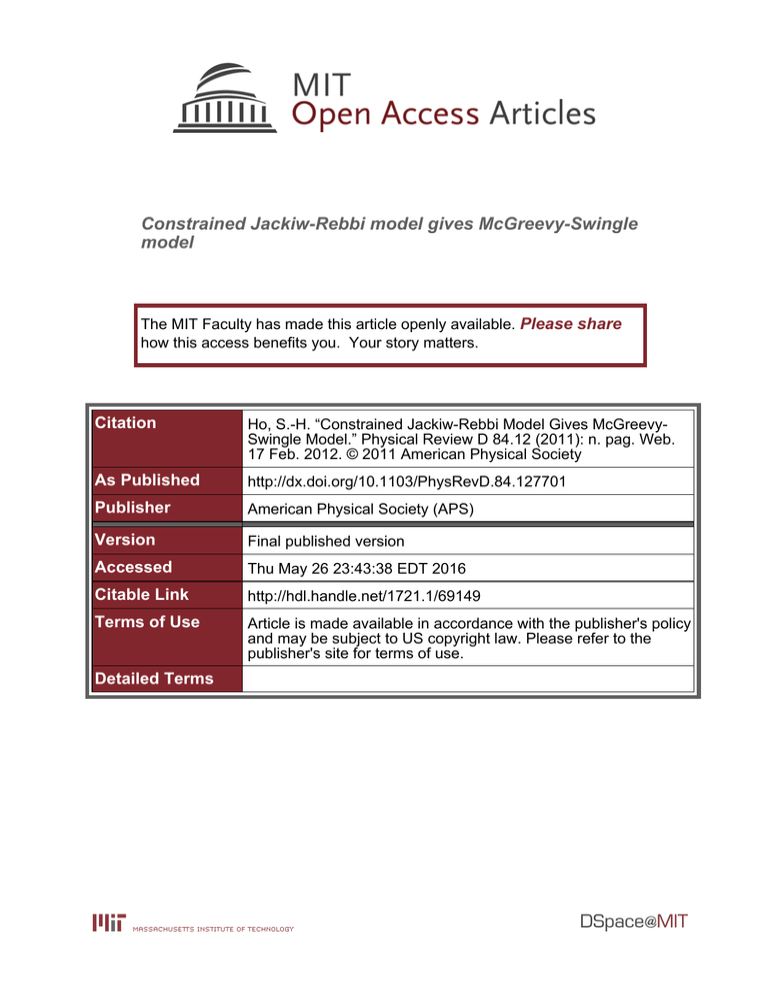
Constrained Jackiw-Rebbi model gives McGreevy-Swingle model The MIT Faculty has made this article openly available. Please share how this access benefits you. Your story matters. Citation Ho, S.-H. “Constrained Jackiw-Rebbi Model Gives McGreevySwingle Model.” Physical Review D 84.12 (2011): n. pag. Web. 17 Feb. 2012. © 2011 American Physical Society As Published http://dx.doi.org/10.1103/PhysRevD.84.127701 Publisher American Physical Society (APS) Version Final published version Accessed Thu May 26 23:43:38 EDT 2016 Citable Link http://hdl.handle.net/1721.1/69149 Terms of Use Article is made available in accordance with the publisher's policy and may be subject to US copyright law. Please refer to the publisher's site for terms of use. Detailed Terms PHYSICAL REVIEW D 84, 127701 (2011) Constrained Jackiw-Rebbi model gives McGreevy-Swingle model S.-H. Ho Center for Theoretical Physics, Massachusetts Institute of Technology, Cambridge, Massachusetts 02139, USA (Received 25 August 2011; published 14 December 2011) We show that the recently considered McGreevy-Swingle model for Majorana fermions in the presence of a ’t Hooft-Polyakov magnetic monopole arises when the Jackiw-Rebbi model is constrained to be conjugation self dual. DOI: 10.1103/PhysRevD.84.127701 PACS numbers: 03.65.Pm, 03.65.w The Dirac equation in a topological background has been studied in various dimensions, such as the background of a kink in one spatial dimension, a vortex in two spatial dimensions, a ’t Hooft-Polyakov magnetic monopole and a dyon in three dimensions [1,2], and there exist normalizable Dirac zero modes in all cases. The zero modes of Majorana fermions, however, are only found in the cases of a kink in one dimension [1] and a vortex background in two dimensions [2]. A well separated pair of Majorana zero modes can define a quibit since it is a degenerate two-state system, whose state is stored nonlocally [3]. Because of this feature and obeying nonAbelian statistics, Majorana zero modes caught a lot of attention in physics because of its potential application on quantum computing [4]. Recently, McGreevy and Swingle considered a three spatial dimension model for Weyl fermions coupled to a ’t Hooft-Polyakov monopole and a scalar field in the SUð2Þ adjoint representation [5,6]. In [5], they solved the zero mode Dirac equation explicitly and found the exact solutions for the Majorana zero modes. In this brief report, we show that the Jackiw-Rebbi model with a Dirac fermion in the fundamental representation of SUð2Þ gauge group, once the conjugation condition is imposed on the Dirac field, reproduces the single Wyel fermion case of McGreevy-Swingle model. This indicates that the Majorana feature of the model is not only shown in the zero mode, but in the whole field. However, the quantum version of the theory is problematic because of the Witten anomaly [5,7]. Let us start from the Lagrangian density (3.1) in [1]: A L ¼ c a i ðD Þab c b gG c a Tab c b A ; A ðD Þab ¼ @ ab igAA Tab (1a) (1b) where c a is a four-component Dirac spinor and a twocomponent SUð2Þ isospinor, AA is the vector potential, T A is the SUð2Þ generator, g ¼ diagðþ1; 1; 1; 1Þ and G is a positive dimensionless coupling constant. Here ða; bÞ are isospin indices while spin indices are suppressed. (We work in the chiral representation for the gamma matrices and the fundamental representation for the 1550-7998= 2011=84(12)=127701(2) SUð2Þ matrices. Thus we use gamma matrix conventions of [5] rather than [1].) ¼ TA ¼ A ; 2 0 ; 0 (1c) A ¼ 1; 2; 3 (1d) Here ¼ ð1; Þ ~ and ¼ ð1; Þ. ~ From (1a) we can derive the Dirac equation g A A gG A A cb ¼ 0 i @ ab i A ab 2 2 ab (2) or equivalently g gG A A ~ ab þ ~ A~ A Aab þ ab c b Hab c b ~ p 2 2 ¼ i@t c a ¼ E c a ; (3a) ~ p~ ¼ ir; (3b) ! ! ~ 0 0 1 ~ ¼ 0 ~ ¼ ; ¼ 0 ¼ : (3c) 0 ~ 1 0 The conjugated field 0 i2 c i2ab c b Cab c b ca i2 0 (4) satisfies the equation Hab c cb ¼ E c ca (5) ðCHC1 Þab ¼ ðH Þab : (6) owing to Now we impose the conjugation constraint on the Dirac a spinor a ¼ , a 127701-1 ca ¼ a ; a ¼ i2 i2ab b ; (7a) a ¼ i2 i2ab b : (7b) Ó 2011 American Physical Society BRIEF REPORTS PHYSICAL REVIEW D 84, 127701 (2011) Replacing the unconstrained Dirac spinor c a by the constrained a we can rewrite (1a) in terms of the twocomponent field a : 1 0 gG A A @ ig AA A i ab ab 2 ab 2 C B C L¼ ya B Ab @ A A @ ig AA A gG i ab ab 2 2 ab (8) ¼ 2ya i ig A A @ ab A ab b 2 gG 2 A ði Þab A i2 b 2 a gG y A 2 a ði Þab A i2 b 2 a conjugation constraint is imposed, the equation reduces to two components and describes Majorana fermions [8]. We have shown that the McGS model emerges when the energy reflection conjugation is imposed on JR model with a Dirac fermion in SUð2Þ fundamental representation. Here we also note that the Majorana fermion in SUð2Þ adjoint representation in JR model cannot be achieved since it seems to be no way to impose the conjugation constraint in isovector fermion case.1 We thank R. Jackiw for suggesting this calculation and for discussion with J. McGreevy and B. Swingle. This work is supported by the National Science Council of R.O.C. under Grant No. NSC98-2917-I-564-122. (9) This is Equation (2.1) in [5]. The single zero mode c 0a is present both in the unconstrained JR model and the constrained McGS model since its mode function satisfies c 0a ¼ Cab c 0 b . A similar story has been told in two spatial dimensions: an unconstrained Dirac equation with conjugation properties like (4) and (5) describes graphene; when In the case of isovector fermion, the corresponding conjugated field is defined by 0 i2 ca a : 2 i 0 [1] R. Jackiw and C. Rebbi, Phys. Rev. D 13, 3398 (1976). [2] R. Jackiw and P. Rossi, Nucl. Phys. B190, 681 (1981). [3] M. Z. Hasan and C. L. Kane, Rev. Mod. Phys. 82, 3045 (2010). [4] C. Nayak, S. H. Simon, A. Stern, M. Freedman, and S. Das Sarma, Rev. Mod. Phys. 80, 1083 (2008). [5] J. McGreevy and B. Swingle, Phys. Rev. D 84, 065019 (2011). [6] For most recent studies of Majorana zero mode in three spatial dimension which motivated the study in [5], see: J. C. Y. Teo and C. L. Kane, Phys. Rev. Lett. 104, 046401 (2010); M. Freedman, M. B. Hastings, C. Nayak, X.-L. Qi, K. Walker, and Z. Wang, Phys. Rev. B 83, 115132 (2011); M. Freedman, M. B. Hastings, C. Nayak, and X.-L. Qi, arXiv:1107.2731. [7] E. Witten, Phys. Lett. B 117, 324 (1982). [8] C. Chamon, R. Jackiw, Y. Nishida, S. Y. Pi, and L. Santos, Phys. Rev. B 81, 224515 (2010). 1 Once we impose the conjugation constraint c ¼ we only have the trivial solution ¼ 0. 127701-2

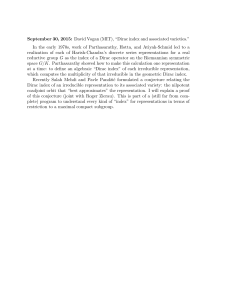
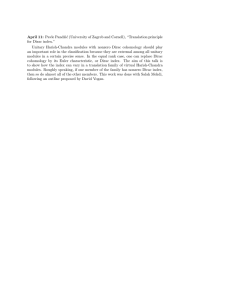

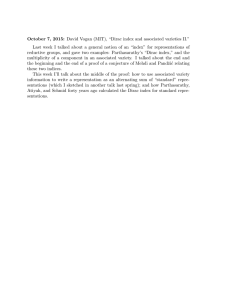
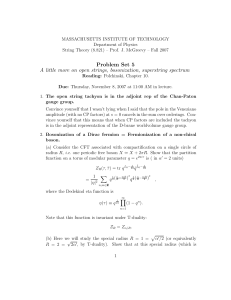
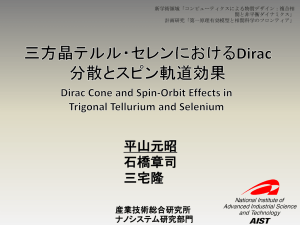
![arXiv:1112.1950v2 [cond-mat.mes-hall] 12 Apr 2012 - manep-nccr](http://s2.studylib.net/store/data/018900326_1-31923303162b8ca6d465331441bbd0df-300x300.png)